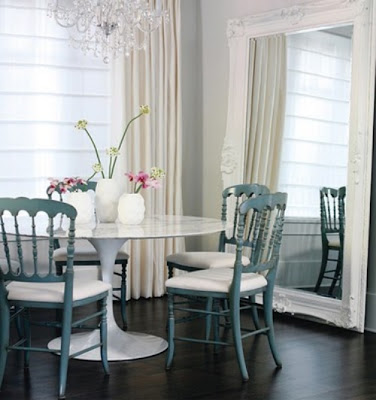For a room that needs a little excitement, adding a rug could be a perfect answer. I like to use rugs to complete the room or to tie everything together. Rugs had definition, warmth, and personality to a space.
Disclaimer: Before I begin this little tutorial, I want you to know I AM NOT AN EXPERT. I am only a student so what I say doesn't mean that it's right and wrong. My blog is a guide to help you create a better look for your space. If I say I don't like something or use one of my Naterisms*, that doesn't mean go throw it away and buy something new. Interior design is all about taste. Your taste might be different from mine and our personalities might be different. Do what works for you!
Back to rugs. I know you're excited. So how do you best use a rug? Glad you asked. Number one rule when using a rug in a space: it either all goes on the rug or nothing goes on the rug. However, there is one exception. Let's say you have a coffee table, a side chair, and a decorative table. The coffee table can sit on the rug by itself but the chair and the table need to both touch the rug or both stay off of it. Make sense?
Now that we've got that out of the way... That's just a huge pet peeve of mine and I've been known to move furniture if it's set up wrong. Hehe...
Use a rug when you need to split up a big room from different spaces. For example, if you have a room that provides a place of eating and entertainment, you can 1) use one rug in the living space or 2) use two in both the dining room and the living room. Both look really well. When using more than one rug in a space, make sure they are not the same size. Same size rugs cut your space in half visually. You want your space to look cohesive. To keep harmony in your space when you are using two rugs, make sure the rugs compliment each other. If two rugs are completely different, your space looses that cohesiveness.
Most people find it difficult to pick out a rug after their space is put together. The answer to that problem is to pick out the rug beforehand. Decorative rugs are like artwork. If you want your rug to impact your space focally, then choose it before you pick out paint and furniture. Use a large scaled, decorative rug if you have solid furniture. The rug will pump up the volume but just enough. Too much pattern can be overwhelming and distracting. That also works vise versa. If you have pattern on your walls and in your accessories, a solid rug will look best. The rug will quieten the room visually.
Don't assume that your rug has to be a rectangle. Let the way you group your furniture dictate the shape of your rug. There are square, oval, and round options as well. Move your furniture around and see what works best. There are also companies that sell custom rugs to fit your space. Try those too.
When you buy a room size rug, subtract 3 feet from the length and width of the room. Leaving the floor bare at the edges makes it look a little larger. Also, when laying a rug under your dining table, leave at least 24" of rug from the edge of the table out on all sides. This enables the back legs of the chairs to stay on the rug, even when pulled out to let someone sit.
A fun thing to do, but something you need to try out first, is layering rugs. Use a solid rug on the bottom and try a fun rug on top. Add some interest with different shapes.
Always use a liner to keep your rug from slipping or creeping. The rug liner should be appropriate for your floor type.
Experimenting with rugs is okay to do but whatever you do, don't do this.
*Naterism: A rule made up by me, only to save you the embarrassment,
base off of things people try to do themselves that doesn't look good at all.
base off of things people try to do themselves that doesn't look good at all.
























































